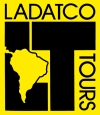

Destinations
Experiences
 |
L A
D A T C O T O U R
S |
 |
||||||||
| HOME | South America | Falkland Islands | Antarctica | Unique Destinations |
Unique Experiences |
Newsstand | ||||
|
Jesuit
Missions |
|
JESUIT MISSIONS - courtesy of InterTours, Paraguay:
"The Jesuit World" is the route that allows us
getting to know the history of Jesuits in this region, the foundation of the Jesuitical
Province of Paraguay, the attempt to evangelize the natives by these brave priests, and
their struggle to protect them from slavery. The visits to the remaining archeological
sites take us to relive the heroic acts of these players, be it from the native's point of
view, perhaps his only option for survival to the frantic colonization, or from the point
of view of the Jesuit, a cultured and intelligent man giving—very often—his life
for a cause.
This route may be taken by those groups or individuals wishing to delve deeper into this
history, like students, religious people, etc., or combined with another interest like
adventure itineraries, ecotourism, ranches, etc.
In Paraguay
San Ignacio Guazú
Called Guazú (big) to distinguish it from the newer San Ignacio Miní (now in Argentina),
this reduction was founded in 1609-1610 by invitation of the famous chief Arapyzandú and
moved definitively to its current location in 1677. This locality is on the route between
Asunción and Encarnación – Paraguay. At the city's main square, there is a statue
of lay brother Beato Roque González, indicating the significance of this priest in the
development of San Ignacio Guazú. Unfortunately, nothing was left of the main church
completed in 1694. However, in the old and still preserved cloister, there is an excellent
museum that contains statues that decorated the several reductions of present Paraguay and
remains of the old church; they even kept the original colors. At the portal to this
building, there is an inscription with the name of the 26 Jesuits that died as martyrs in
the missions of Paraguay, being the first three the "beatified" ones of
Paraguay.
At the end of the visit, at the last portal, one can observe the earth component of the
walls, compacted soil that challenges the centuries; you can also see one of the tree
trunks that were placed whole inside the walls, as if they were an iron beam, used
nowadays in modern constructions. In addition, one can notice the thickness of the walls,
optimum thermal insulators, maintaining the ideal temperature in winter and summer.
Santa María de Fe
It was founded in 1647 by the French priest Manuel Berthod, who was given this name in
honor of the famous "Notre Dame of Foy."
Almost nothing remains of the old mission, as its church was destroyed by a fire in 1889.
Many of the images and statues survived the fire and may be appreciated at the current
church. The visit is worthwhile because of the nice museum that, as compared to that of
San Ignacio Guazú, contains several chambers, each one of them dedicated to one subject.
Statues and images of Santa Maria, San Ignacio, San Francisco Javier, San Pedro and
others.
Santa Rosa
Approximately 150 km away from Encarnación on the route to Asunción, it was founded in
1698 with families from Santa Maria de Fe. In 1883, the original church was destroyed by a
fire. On top of the old church, they built the new one, which incorporated some pilasters
of the old church into its façade.
The most interesting thing are the intact remnants of the original bell tower and the
chapel Nuestra Señora de Loreto. In this chapel, we see the frescos painted on its walls
and a group of sculptures representing the Annunciation, the true jewel of the baroque
style.
Santiago
Easy access through a paved road. Founded in 1651, it was moved in 1669 to its current
location. Almost nothing is left of the old mission, only the most interesting museum that
was built there. Almost a replica of the museum at San Ignacio Guazú, it has set of
entirely original statues. In the museum, a large window opens to a splendid view of the
group of ruins of the old mission, which gives us the feeling of traveling to that time.
San Cosme y Damián
In 1632, Father Adriano Fornoso founded this mission on Brazilian land. Changing its
location several times, it was established for the last time in 1740 in its present
location. In spite of being one of the least interesting ones from the architectural point
of view, this mission was the main center of astronomic studies in South America, having
been organized by father Buenaventura Suárez, who maintained contact with the most
important astronomers in Europe, with his work being recognized by them.
Helped by the natives, Father Suárez built telescopes, dials, and a sundial that,
although rudimentary, provided accurate data. The sundial can be checked and admired until
today. The old mission church had one of its parts destroyed by a fire, and the other part
was reconstructed into a new church. There are several statues inside this
church—including one of San Cosme y Damián—that are worth seeing.
Trinidad
Located about 25 km away from Encarnación, on the route to Ciudad del Este –
Paraguay, is one of the most interesting and suggestive ruins of all.
Trinidad was founded by natives that came from the mission of San Carlos in what is now
Argentina. Its main architects were fathers Juan Bautista Prímoli of Milan and the
Catalan Jose Grimau. Uncompleted, this mission had one of the larges and prettiest
churches of all missions, according to descriptions by travelers of that period.
After crossing the nave of the old church, we encounter the impressive view of the frieze
high on the altar wall, entirely decorated on the very stone, with a sequence of angels in
baroque postures and their instruments. The two doors giving access to the sacristies are
worth mentioning: the columns with disproportionate capitals and a triple row of leaves
supporting the frieze with two lateral pillars and a sculptural motif in the center.
During the excavations in the church, they found interesting statues (with their original
color) and bones of some missionaries buried there. On the west side are the ruins of the
tower and a long chapel. The tower, with a square base, reminds us of a fort tower and it
is not known whether it was a belfry, an observation tower, or both at the same time. The
chapel was probably used while the main church was being built. One of the sacristies also
holds a small museum with local items (in original colors) and a scale model of the
mission. A must see!
Declared Patrimony of Humanity in 1993 by UNESCO.
Jesús de Tavarangue
Almost opposite Trinidad, on the other side of the main road, is the reduction that can be
accessed through a dirt road (15 km), sometimes impossible to use, depending on the
weather.
This church was not completed, because of the expulsion of the Jesuits. Its architectural
conception was very different from the others.
In Moorish style, unique among all of the reductions, the three doors to enter the temple
are exceptionally beautiful, constructed in trefoil arches. The ceiling was probably not
made of wood or stone like the others, but in mixed style with supporting walls and large
central pilasters. Unfortunately not even the ceiling was finished.
Declared Patrimony of Humanity in 1993 by UNESCO.
Jesuit Ruis in Misiones, Argentina